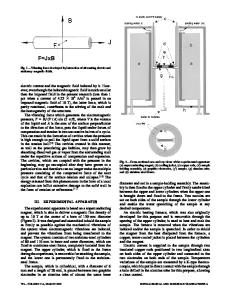Optoelectronic stroboscopic system for measurement of the frequency of harmonic vibrations based on the use of a genetic
- PDF / 241,103 Bytes
- 6 Pages / 595.276 x 793.701 pts Page_size
- 16 Downloads / 239 Views
MECHANICAL MEASUREMENTS OPTOELECTRONIC STROBOSCOPIC SYSTEM FOR MEASUREMENT OF THE FREQUENCY OF HARMONIC VIBRATIONS BASED ON THE USE OF A GENETIC ALGORITHM
E. A. Zryumov, P. A. Zryumov, and S. P. Pronin
UDC 53.082.5:534.647
Principles underlying the design of optoelectronic measurement systems based on the use of a genetic algorithm are presented. A method and means of measuring the frequency of a harmonic vibration, where detection of a stroboscopic effect by means of a high-speed video camera serves as the measurement criterion, are proposed. Optimization of the search for the vibration frequency in the image of a test object is performed by means of a genetic algorithm. Keywords: genetic algorithm, harmonic vibration, intelligent measurement system, optical measurement method, stroboscopic effect, high-speed video camera.
Optical measurement systems are now used in many areas of science and technology, particularly in the measurement of the frequency of harmonic vibrations. The high technical characteristics, acceptable cost, and the fact that the video image may be processed in real time are all advantages of engineering vision systems. Their operating principle is based on obtaining as many frames as possible for subsequent reconstruction of the signal. Any effort to increase measurement precision entails increasing the digitization frequency, that is, the video camera’s vertical scan frequency, which, however, complicates the measurement system. A given level of precision of measurement of the harmonic vibration frequency can be attained by a simpler method with the use of the stroboscopic effect [1]. However, it is then necessary to process a large number of frames corresponding to each of the video camera’s vertical scan frequencies, which reduces the efficiency of the measurement system. The problem may be solved through the application of a genetic algorithm. The frequency ƒ0 of a harmonic vibration may be measured by determining (from discrete readings of the optical image of a test object) the value of the vibration period T0, since ƒ0 = 1/T0. According to the theory of errors, the absolute and relative errors of a measurement of the frequency of a harmonic vibration [2] are given as Δƒ0 = ΔT0(∂ƒ/∂T0) = ΔT0 /T02; δƒ0 = (Δƒ0/ƒ0)·100 = (ΔT0 /T02)T0·100 = (ΔT0 /T0)·100. In measuring the period of a harmonic vibration, the quantity ΔT0 is defined as the difference between the measurement time interval Tm, which is equal to the product of the number of readings N times the digitization period ts, and the true vibration period T0: ΔT0 = Tm – T0 = Nts – T0. Altai Polzynov State Technical University, Barnaul, Russia; e-mail: [email protected]. Translated from Izmeritel’naya Tekhnika, No. 4, pp. 35–38, April, 2012. Original article submitted June 2, 2011. 0543-1972/12/5504-0425 ©2012 Springer Science+Business Media, Inc.
425
Fig. 1. Examples of graphics files obtained by means of a linear CCD photodetector with period of vibration of the object T0 = 40000 μsec: a) ts = 40000 μsec, D = 33.1 rel. units; b) ts
Data Loading...











